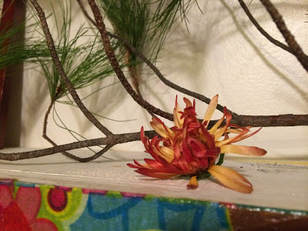A Gift of Pine (and some red cedar)From the archives! Originally posted November 2014. Fall time is root time. As the weather cools, field and woodland plants lose their green colors, exchanging them for a multitude of brown, tan, neutral shades. The energies of many plants turn downwards and inwards, back to their roots, in preparation for the dormancy of wintertime. Other plants brown and die, having completed their life cycle. Seeds dance in the air from milkweed pods and goldenrod fluff, catching on my coat as I walk by. On a windy fall day I help the milkweed along, pulling a handful of fluffy seeds from the dry pods and flinging them exuberantly into the breeze. They dance lightly on the wind and settle in the plants nearby. I always think of Fantasia when I do this, like I am one of the fairies in the Waltz of the Flowers: Last weekend I set out in search of mullein and teasel roots specifically, with an open mind to whatever else I might find that wanted to come home with me. Oftentimes I will have a goal in mind when I go wildcrafting, with a plant or several that I am looking for. I generally find what I am looking for, as well as plenty of plant friends I was not seeking! This particular trip saw me arrive home with mullein root and leaf, teasel root and leaf, plantain leaf, a few handfuls of teensy wild rose hips, two burdock roots, and - the totally unplanned pleasant surprise - a bagful of branches and needles from three types of conifer. In the field and without my tree books, I guessed pine and eastern red cedar. Later at home, using live specimens and photos I'd taken of the trees, I identified them as White Pine, Red Pine, and Eastern Red Cedar (shown left to right in the picture below). I will confess right now - I don't know as much about trees as I do about plants. I am not confident that my harvesting will not be painful for the tree, or difficult to recover from. I also am made hesitant by their long lives and slow growing times. I worry that I will do them damage. That said, I am certain that trees make medicine just as vital as the plants I know, and I am eager to learn about how to use tree medicine. In this particular wildcrafting spot, there is the occasional conifer to be found amongst the hardwoods and fields. These trees are often large, old, tall, and many-branched. They are surrounded by a carpet of shed needles that softens the space and makes me feel quiet and reverent. A cone of silence, if you will. I stepped off the path to vist one of these friendly giants. This particular tree's lowest branches began growing more than 5 feet off the ground, higher than I could reach. The branches extended down and out, so that I had to duck under the needles at the farthest ends. No one wants a pine needle in the eye! As I slowly walked around the base of the tree, admiring, I thought of my tree medicine conundrum. How to learn about trees and make medicine without hurting the tree? Ah well, I thought. Perhaps tree medicine is part of my future, once I learn more about them and "how to do it right." I thanked the tree for our nice quiet visit and turned to head back to the path when I noticed a small branch of bright green needles, barely hanging on to the main branch by a thin strip of bark. It must have broken in the 20+mph autumn winds the day before. Here was an answer to my internal question! A recently broken branch, still alive and green with piney goodness, right there in front of me. I picked it. This little branch was really more of a twig, about a foot long with three bunches of bright green needles. I put it in my bag, thinking of the lovely experimental medicine to be made with pine and honey. Then I had another thought...if the wind had broken this branch, might there be more? Once I started to pay attention I saw several vital-looking, green twigs and branches waiting quietly to be noticed. I put some of these in my bag, too. What a good solution! Provided the bits and pieces shed from the tree are still as green and vital as they would be on the tree, I have no problem using them for my experimental medicine. In other words, since I am learning about pine, and I will primarily be the one sampling and testing medicine made from this pine, I have no qualms about using the windfall I find on and near the tree. I may revise this opinion and harvesting method in future, or when I am making medicine for others to use, but for me and for now, it is an excellent solution. Once home and properly fed, I identified the conifers that came home with me (see picture above, of samples on my little red table). Here's another picture of them all together: Once ID was confirmed and facts checked, I made medicine! Here's a short list of what I made:
-White Pine Elixir -White Pine infused honey I'm also drying some branches for making tea, and I have a pine oil/salve in mind too. Details and pictures will follow in a separate post, because I'm feeling a bit long-winded with this one. I'll leave you with a final picture, of my lone garden-grown calendula flower harvest, drying alongside a white pine branch in my kitchen.
0 Comments
Leave a Reply. |
Author
Herbalist plant ramblings and adventures in green medicine, by Linden Tree Herbals potion-maker Ginny. CategoriesArchives |
| Linden Tree Herbals | . |
Proudly powered by Weebly




 RSS Feed
RSS Feed